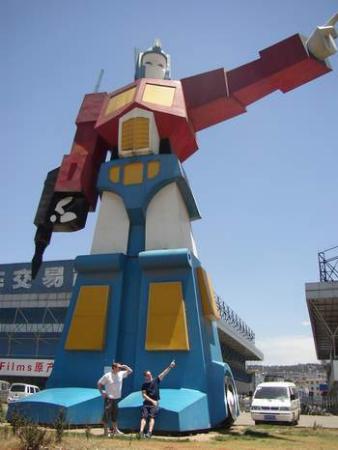 One of the images in Apocalypse Now that came to mind when I read this passage was that of the downed Huey helicopter lying in flames. The Huey is often considered the workhorse of the Vietnam war, and, in the beginning of the movie, the helicopter is shown most often as flying triumphantly through sky, especially with "Ride of the Valkieries" playing behind it or Playboy bunnies dancing in front of it. However, towards the end of the movie, it is only shown as hanging in a tree or lying in a ditch, its crew nowhere to be found, accompanied only by eerie techno music. It looks just as much like "the carcass of some dead animal" as the railway-truck. The technological might of the Huey is no match or the harsh realities of war.
One of the images in Apocalypse Now that came to mind when I read this passage was that of the downed Huey helicopter lying in flames. The Huey is often considered the workhorse of the Vietnam war, and, in the beginning of the movie, the helicopter is shown most often as flying triumphantly through sky, especially with "Ride of the Valkieries" playing behind it or Playboy bunnies dancing in front of it. However, towards the end of the movie, it is only shown as hanging in a tree or lying in a ditch, its crew nowhere to be found, accompanied only by eerie techno music. It looks just as much like "the carcass of some dead animal" as the railway-truck. The technological might of the Huey is no match or the harsh realities of war. Like the Huey, the railway-truck can also be considered the workhorse of the European colonizers. It was designed to carry things great distances, and, like the Huey, it is a symbol of industrial superiority. This rotting piece of industrial might is one of the first things Marlow sees when he arrives at the first outpost, and it signifies the things to come; the Imperial "workhorse" that Marlow will try to find, Kurtz, is also rotting, if only in his soul (the same can be said of Apocalypse Now's Colonel Kurtz).
Like the Huey, the railway-truck can also be considered the workhorse of the European colonizers. It was designed to carry things great distances, and, like the Huey, it is a symbol of industrial superiority. This rotting piece of industrial might is one of the first things Marlow sees when he arrives at the first outpost, and it signifies the things to come; the Imperial "workhorse" that Marlow will try to find, Kurtz, is also rotting, if only in his soul (the same can be said of Apocalypse Now's Colonel Kurtz).Both the Huey and the railway-truck are technological advancements that were used by a large power to assert its will over a much weaker culture. By showing both as "carcass[es]," Apocalypse Now and Heart of Darkness are alluding how such a crusade can destroy not only the oppressed, but also the oppressors, as shown by both Kurtzes.
